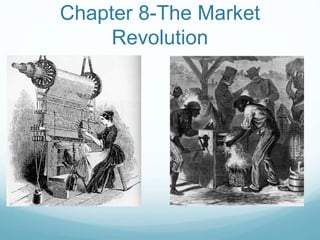
Eep ch 8 march 11
- 2. Objectives By the end of today’s class, you should be able to: -Describe the role of the bank and how it lead to economic growth. -Compare/contrast the economies of the North versus the South.
- 3. Chapter 8 Section 1 A Market Economy After the War of 1812 the American economy soared. Known as Market Revolution (change in the way Americans made, bought, or sold goods) Changes in the Market Revolution are based on a free enterprise system (system in which companies compete for profits) Rewarded people for finding better, faster, and more efficient ways of running their business.
- 4. Economic Growth of Banks Financial institutions played a big role in the expansion of manufacturing and commerce. Banks provided capital, or wealth that can be invested to produce goods and make money. People deal in coin, most common form of money: bank notes (checks) Problems with Banks: Uncontrolled Lending-States did not restrict how much money a bank kept. Banks made bad loans, people couldn’t pay bank back.
- 5. Panic of 1819 As early as 1814, Thomas Jefferson had warned “We are ruined by paper. We are under a bank bubble that would soon burst.” Formation of a Second Bank was supposed to steady the economy. Yet lead to the first major Depression in the US. “Era of Good Feelings” reflects the growing feelings of national unity. Yet, a severe economic depression between 1819-1822 called into question banks/tariffs.
- 6. Panic of 1819 Causes: Dramatic decline in cotton prices, an 1817 Congressional order requiring “hard-currency” payments for land, and closing of factories due to foreign competition. It was an era of bad loans/embezzlement. European demands for goods like cotton and tobacco increased. Now, credit is unavailable to most, big cities suffer, farmers suffer, banks fail, sale of land plummet, and unemployment rises. Leads to a mistrust of bankers, bankers, and paper money.
- 7. Economy of the North Northwest: Farming- What was produced is shipped to England. Northeast: Industry-With industry, there is a shift to cities. We see a growth of cities, which leads to an increase in tenement housing. Cities are unable to handle these rapid increases. Factories/Textile Mills: Lowell Mills, mostly women workers, paid $2 a week, lived in boarding house.
- 9. Economy of the North-The Formation of Labor Unions Workers at the mills go on strike over unfair working conditions, long hours, and low payment. This leads to the formation of labor unions, or an organization of workers formed to protect the interests of its members. Negotiate (and hopefully resolve) issues such as wages, working conditions, etc. First labor union is the National Trades Union. Membership skyrockets, experiences a large growth early on. Declines sharply after management steps in.
- 10. Economy of the South Cotton is king! By 1860, cotton consists of 2/3 of the total value of American exports= $$$$ for the South. Where the north was developing into an urban society, the South was rural (farms/countryside) Better weather conditions means more time to harvesting cotton as well as the Cotton Gin.
- 11. Economy of the South- System of Slavery Slave trade ended in 1804, but the system of slavery still firmly in place. Population of slaves about 1.5 million in the 1820s. Population will double by the Civil War. Life for slaves on small farms different than life on a larger plantation. The South saw farming as a business and slaves as property. As the demand for slaves goes up, so do the prices.
- 12. Slave Rebellions Only small percentage of slaves ever escaped. Most rebellions and revolts were small, spontaneous, and end in failure. One famous rebellion, was Turner’s Rebellion in 1831 in Virginia. It was one of the most violent slave revolts. Leader was Nat Turner. Turner, a slave, deeply into religion, believed that he alone could eradicate slavery.
- 13. Turner’s Rebellion Turner felt that it was “God’s will” that he lead this rebellion. Around 60 enslaved/free blacks join Turner. The men went house to house freeing slaves and killing “all white people they encountered.” 55- 65 killed. Slaves charged with treason The rebellion caused massive fear on farmers/plantation owners. Therefore, tighter restrictions were placed on slaves.
- 14. Homework: Period D: If NOT going on retreat tomorrow: -Read Election of 1824 article. Period D: If GOING on retreat tomorrow: -Read Election of 1824 article, write summary -Review Chapter 8 Section 4
- 15. Homework Period G: If NOT going on retreat tomorrow -Read Election of 1824 article. Period G: If GOING on retreat tomorrow (due FRI) -Read Election of 1824 article, write summary. -Look over Chapter 8 Section 4 -Try and complete Jackson Ticket sheet -Chapter 8 Section 5 Jackson’s Presidency
